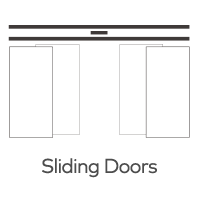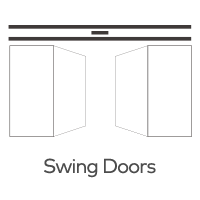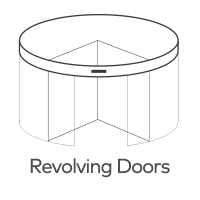How do motion sensors work in automatic glass doors, and what are the key considerations for their placement and sensitivity settings?
Automatic glass doors have become a ubiquitous part of modern architecture, providing convenience, energy efficiency, and enhanced accessibility. A critical component that makes these doors intelligent and user-friendly is the motion sensor. In this article, we will delve into how motion sensors work in automatic glass doors and the essential considerations for their placement and sensitivity settings.

How Motion Sensors Work:
Motion sensors used in automatic glass doors primarily rely on two key technologies:
1. Passive Infrared (PIR) Sensors:
PIR sensors detect changes in infrared radiation within their field of view. When a warm object, like a person, enters this field, it triggers a change in the sensor's signal. The sensor processes this change and sends a signal to the door control system, which then activates the door's opening mechanism.
2. Active Infrared (IR) Sensors:
Active IR sensors work by emitting infrared beams across the door's entryway. When an object, such as a person or a vehicle, interrupts these beams, it signals the door to open. This type of sensor is commonly used in automatic sliding glass doors.
Key Considerations for Placement:
1. Height and Angle:
The height at which you place motion sensors is crucial. For effective operation, sensors are usually installed at a height of about 7 to 8 feet above the ground, ensuring they can detect people and objects at different heights. The angle of installation is also essential, as it determines the sensor's field of view. It should be adjusted to cover the intended area of detection.
2. Coverage Area:
Consider the coverage area of the motion sensor. It should align with the door's width and the expected foot traffic. Be mindful of the fact that coverage area may vary depending on the sensor's design, so it's essential to choose the right sensor model for your specific needs.
3. Avoiding Obstructions:
Ensure that there are no physical obstructions in the sensor's field of view. Objects like furniture, plants, or signage should not block the sensor's path, as this can lead to false activations or prevent the door from opening when needed.
4. Interference:
Be aware of potential interference sources, such as direct sunlight, heating vents, or reflective surfaces that could reflect infrared radiation. Interference can affect the sensor's performance, so take these factors into account when placing the sensor.
Sensitivity Settings:
1. Adjustable Sensitivity:
Most motion sensors have adjustable sensitivity settings. You can fine-tune these settings to determine how easily the sensor responds to motion. Lower sensitivity settings may require a closer approach, while higher settings can detect motion from a more extended distance.
2. Time Delay:
Automatic doors often come with a time delay feature. This setting determines how long the door remains open after detecting motion. Adjusting the time delay can help balance energy efficiency and user convenience.
3. Directional Sensing:
Some motion sensors can be set to detect motion from specific directions, such as people approaching the door from outside or inside the building. This feature is useful for controlling the door's behavior based on the intended direction of travel.
Conclusion:
Motion sensors are an integral part of automatic glass doors, providing not only convenience but also energy efficiency and improved accessibility. By understanding how these sensors work and carefully considering their placement and sensitivity settings, you can ensure that your automatic glass doors function optimally, enhancing both user experience and energy savings.







